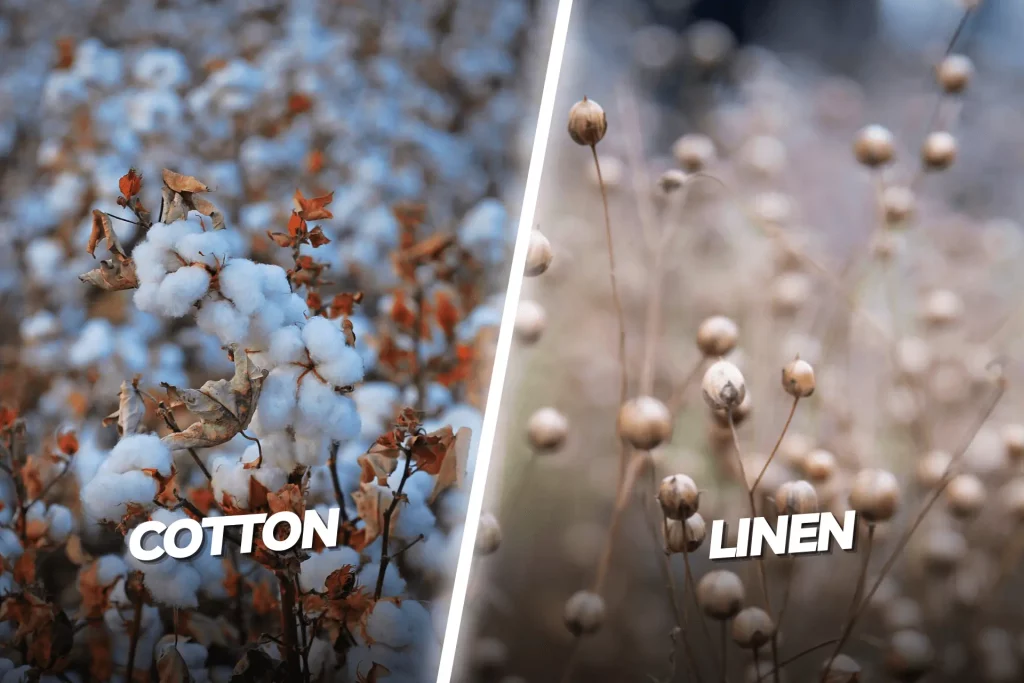When choosing the perfect fabric for your wardrobe and home décor, you may be overwhelmed by all your options. From cotton to linen, so many fabrics can give any look a unique feel — but if you’re stuck between the two most popular choices, cotton vs. linen, this blog post is for you!
We’ll discuss the differences between each textile in breathability and maintenance and styling tips to help get the most out of whichever fabric you choose. Whether you’re looking for something classic or more modern, read on to find out which option best suits your needs and preferences!
Table of Contents
What is Cotton?

The cotton plant yields the natural fiber known as cotton, which originates from the plant. Cotton fibers are more fluffy than linen fibers, and cotton garments are renowned for their adaptability, gentleness, and overall coziness.
Although linen is inherently more durable, cotton textiles are equally challenging because they are produced from many cotton fibers spun and woven together. Because cotton fibers are so much more delicate than linen fibers, they lend themselves to being incorporated into higher thread count textiles, which results in a fabric that is exceptionally smooth and luxurious.
Cotton can absorb up to 25% of its weight in moisture, making it breathable and highly absorbent. However, it does not possess the moisture-wicking qualities of linen; therefore, drying time can be significantly increased. The use of cotton for bedding is recommended for all four seasons since it may be layered to obtain the required level of warmth and comfort.
Cotton sheets, like linen, are best washed in cold water but may endure warmer temperatures if necessary. Bedding made of cotton may also be dried in a dryer using the delicate cycle and either low or medium heat. Cotton bedding requires less maintenance and is ideal for daily usage.
What is Linen?

The flax plant is the source of the long-lasting natural material known as linen. The best linen originates from Europe, especially from Belgium, which has an ideal climate and rich soil that makes it possible for flax to grow solidly and attractively. Bedding made from Belgian linen will allow you to enjoy fibers of a better grade overall.
Fabrics made of linen are much heavier than cotton ones and are also around thirty percent more robust. The first time you touch a linen cloth, it will likely have a more sharp feel to it, but as time passes and the fabric is used, it will become more pliable and soft.
Linen is known for its durability, brilliance, and beautiful drape. Because linen fibers are more substantial than cotton fibers, a lower thread count is required to ensure that linen fabric is of excellent quality and will last a long time.
The absorbency of linen is well-known; it can take up to 20% of its weight in moisture before it begins to feel damp. In addition, it can wick moisture, making it a popular option for keeping bedrooms and sleepers cool. If you tend to sleep hot, choosing linen that breathes well is the best option for you.
When choosing a fabric for bedding, linen is one of the most common options in warmer areas and throughout the summer months. Bedding made of linen should be washed in cold water using the delicate cycle, and they may be dried in the dryer using a peaceful setting and a low heat setting. Compared to cotton, linen is better at preserving texture and creates the appearance of a calm and comfortable bed.
The Characteristics of Cotton and Linen:

- Fabric Made From Natural Sources Linen and cotton have their fibers collected from natural sources such as flax and cotton plants.
- Both cotton and linen may be broken down into parts by natural processes.
- Linen and cotton are two textiles considered skin-friendly because they do not irritate or aggravate the skin in any way. However, cotton is typically chosen for children’s clothing rather than linen.
- Excellent for the colder months as well as, the warmer ones.
Absorbency:
Cotton and linen have a high absorption capacity, and the fibers of both cotton and linen are strengthened by exposure to water. Cotton can hold more than 25% of its weight in water, but linen can only keep up to 20% water by weight. Cotton is more absorbent than linen.
For summer apparel, merino wool is often recommended for its superior moisture-wicking properties. A comparison of merino wool and cotton identifies the cooler and drier fabric.
Durability:
Cotton is more stretchy and flexible than linen, although it is less long-lasting than the latter. Cotton of higher quality, such as Egyptian cotton, is produced using long-staple cotton fibers. This results in cotton that is softer and more durable than regular cotton but less durable than linen.
Softness:
Since flax fibers are coarser than cotton fibers, cotton is more comfortable to wear and touch than linen. Unlike linen sheets, which become very soft after many washes and can last up to thirty years, cotton sheets are pretty soft right out of the box and can last roughly five years.
Sustainability:
The environmental friendliness of linen compared to cotton is a significant distinction between the two materials that are essential to highlight. Growing flax requires relatively little water, pesticides, or fertilizer as it is a very resilient plant. It is also biodegradable and may be utilized in producing various products up until its final component.
Texture:
The first thing you notice about linen is how crisp and subtly it feels in your hands, unlike cotton, which immediately seems fluffy and soft. This is one of the reasons why we adore it. It is also why linen bed sheets typically pass down through generations in a family, gradually becoming softer and more comfortable over time.
Products made of high-quality cotton may also serve you for a considerable time. Still, linen is often considered the most potent natural fiber on the planet, which helps it play a role in producing durable goods. You may purchase linen bedding as a wedding present, which can later be handed down down the generations.
Warmth & Cooling:
Cotton does not transfer heat and possesses insulating qualities comparable to fiberglass, the material typically used to insulate dwellings. Because the fibers of flax and linen are hollow, linen may keep you cool in the summer but must be layered when worn in the cold.
You can be warm in cotton and linen, but if it’s too warm, you’ll be much more comfortable in linen. Because linen is constructed of long, hollow fibers, it allows air to flow freely and does an excellent job of moving around moisture, preventing it from building up.
Are you looking for a cozy and comfortable winter experience? Merino wool is the right choice! For insulated warmth to enjoy the cold days without irritation, check out these merino wool base layers.
Water Wicking:
Additionally, linen is naturally water-wicking, absorbing moisture from the skin (in this case, sweat), and dries out very rapidly. Cotton is another material that performs an excellent job of wicking moisture, although it has a different inherent wicking power than linen.
When Compared to Cotton, Why is Linen Priced so much Higher?
The only reason linen is so much more costly than cotton is that there is such a limited supply of linen on the market for garments. The process of extracting linen fabric from the flax plant is not only arduous but also time-consuming.
Farmers need to take special care of the plants during harvesting to obtain linen with long fibers. The flax plant produces linen from its weak and easily breakable stalk. If the stalk is broken into too many pieces, the resulting fibers will be longer for linen production. The long strands of makeup linen give the fabric its durability and strength.
They are forced to move at a leisurely pace, which extends the overall duration of the procedure. Because the machinery that separates the fibers from the stalk works so slowly, the weaving process takes a very lengthy time.
In addition to gathering resources and weaving, there is another significant factor, and that is because of location. As a result of the fact that linen thrives in damp environments, Russia is the world’s most prominent planter of linen, while China is the top manufacturer of linen.
Egypt and Spain are also in the lineup, although they only produce a small amount of linen between them. As a result, cotton is less readily available on the market than cotton is, contributing to the higher cost of linen as a fabric.
Frequently Asked Questions:
Are cotton and linen the same?
No, cotton and linen are different. Cotton is a soft, lightweight fabric that is breathable and comfortable. It’s made from natural fibers derived from the cotton plant. On the other hand, Linen is a strong, durable fabric with a stiff texture. It’s made from flax fibers extracted from the stems of the flax plant.
Are linen sheets better than cotton?
When shopping for bed sheets, one of the most popular materials you’ll encounter is linen. But does linen have advantages compared to other fabrics, such as cotton? The answer is yes! While linen and cotton are excellent bed sheets, a few key differences make linen a better choice in certain situations.
Is linen quick drying?
Linen is a great fabric choice if you’re looking for something lightweight and quick-drying. It absorbs moisture quickly, making it ideal for warm summer days. Plus, the fabric is incredibly breathable, so you won’t have to worry about feeling too hot or uncomfortable in humid conditions. As a bonus, linen also doesn’t wrinkle too quickly, meaning you won’t have to worry about ironing or treating your garments.
Bottom Line:
Both cotton and linen are attractive options for those who prioritize comfort. Even though cotton is typically sold at a lesser cost and requires little effort to clean, linen has superior sustainability and better durability, both of which expand its lifespan and make it an excellent choice for long-term investment due to its increased lifespan.

